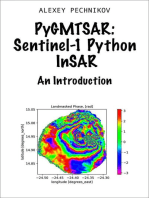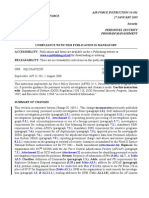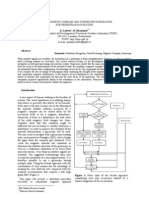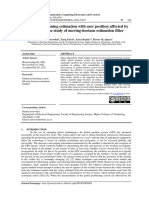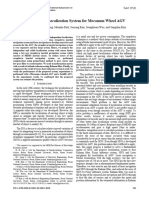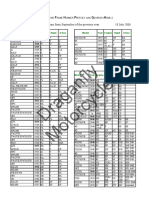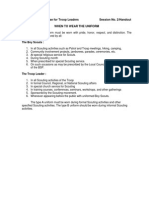Professional Documents
Culture Documents
A Kalman Filtering Approach For Integrating MEMS-based INS and GPS For Land Vehicle Applications
A Kalman Filtering Approach For Integrating MEMS-based INS and GPS For Land Vehicle Applications
Uploaded by
Thời Hoa ĐỏOriginal Description:
Original Title
Copyright
Available Formats
Share this document
Did you find this document useful?
Is this content inappropriate?
Report this DocumentCopyright:
Available Formats
A Kalman Filtering Approach For Integrating MEMS-based INS and GPS For Land Vehicle Applications
A Kalman Filtering Approach For Integrating MEMS-based INS and GPS For Land Vehicle Applications
Uploaded by
Thời Hoa ĐỏCopyright:
Available Formats
A Kalman ltering approach for Integrating MEMS-based INS and GPS for
land vehicle applications
Ashish Kumar Gupta
Dept. of Electrical Engineering
Indian Institute of Technology, Madras
ee05s011@iitm.ac.in
S.S. Sarma Evani
Dept. of Electrical Engineering
Indian Institute of Technology, Madras
ee05m023@iitm.ac.in
R.David Koilpillai
Dept. of Electrical Engineering
Indian Institute of Technology, Madras
koilpillai@iitm.ac.in
Abstract
Global Positioning System (GPS) and Inertial
Navigation Systems (INS) are used for positioning and
attitude determination in a wide range of applications.
Since the usage of high performance INS is limited
by its high cost, for general application areas low-cost
INS units are used. Over the last few years, a number
of low-cost inertial sensors have become available.
However, these low cost sensors have large errors which
increase with time. So GPS measurements can be used to
correct the INS sensor errors to provide a cost-effective
solution with good accuracy in real-time navigation. The
integration of GPS and INS is done using a Kalman lter,
using the loose coupling method. The application of this
integration strategy for land vehicle navigation system
(LV NS) is discussed. In this paper, the performance
of integration system is discussed under different GPS
availability scenarios.
Keywords- Inertial navigation system, Global posi-
tioning system, Kalman lter.
1. Introduction
The rapidly expanding use of the Global Positioning Sys-
tem (GPS) enables commercial navigation devices to
be more popular and attainable for civilian applications.
GPS provides absolute positioning information covering
any part of the world during day and night [2, 7]. Al-
though GPS measurements are essential information for
our model (in general, for any navigation application),
the situation when GPS signals are unavailable (or) un-
reliable due to signal blockages, must be compensated to
provide continuous navigation solutions [3, 2]. There-
fore, presently, GPS can not be used as a stand alone
system. In order to overcome the unavailability prob-
lem in satellite-based navigation systems (GPS) and also
to be cost-effective, Micro-Electro Mechanical Systems
(MEMS) based inertial sensor technology have pushed
the development of low-cost integrated navigation sys-
tems for general applications [7]. Over the last few years,
the proliferation of low-cost inertial sensors have resulted
in an increasing interest in integrated GPS/INS systems.
Some applications require higher position update in order
of 10 to 100 Hz to track the higher dynamics of the ve-
hicles, but the commercially available GPS receivers can
not provide such higher rates due to additional process-
ing power. On the otherhand, INS, which comprises ac-
celerometers and gyroscopes, is a self-contained system
which provides accurate position, velocity and attitude
information in short intervals at very high update rates
but has time dependent error growth when operated in
stand alone mode [1]. Both the above systems are com-
plementary and hence INS can be used to bridge the gaps
in case of GPS outages. Although, these low-cost sensors
do not perform as well compared to the high-grade sen-
sors, nevertheless, when integrated with GPS the overall
perfomance of the integrated system improves. There are
many ways to couple the GPS and INS - tight coupling
and loose coupling [2, 1]. In this work we focus on sys-
tems using loosely coupled approach.
In loosely coupling mode, the position estimates from
GPS receiver and INS are used as measurements to
Kalman iter, while in tight coupling, the pseudorange
estimates from GPS are used as measurement [10]. Also
loose coupling can be done using open loop and closed
loop. In closed loop systems, the inertail error estimates
from the Kalman lter is fedback to the accelerometers
and gyros raw measurements.
In this paper, Section 2 deals with the system model
where the error state vector and its estimation proce-
dure are explained. In this Section, error modeling using
Gauss-Markov model is presented. Section 3 presents the
Kalman lter modeling for this application. Results are
shown in Section 4, and conclusions are provided in Sec-
tion 5.
2. System Model
Integration of GPS and INS using loose coupling is
shown in Fig.1. In this application, both the sys-
tems are independent of each other. The INS block,
which is shown here, consists of Inertial Measurement
Unit (IMU) and mechanization block [3, 1]. IMU
Home Sessions Authors Session 4.2 | | |
Figure 1: Loose Coupling with feedback
has 3accelerometers to measure the acceleration in
3dimensions and 3gyroscopes to measure the angular
velocities. The Mechanization block converts the IMU
measurements from body frame to required navigation
frame. Then The navigation frame measurements are in-
tegrated to obtain the velocity and the position of the ve-
hicle. Position, velocity and attitude of vehicle from INS
are denoted as r
ins
(deg) , v
ins
(m/s) and
ins
(deg) respec-
tively. Where
r
ins
=
_
ins
ins
h
ins
T
(1)
v
ins
=
_
V
Nins
V
Eins
V
Dins
T
(2)
ins
=
_
Roll Pitch Y aw
T
(3)
where
: lattitude of vehicle position
: Longitude of the vehicle position
h: Height
V
N
: North velocity
V
E
: East velocity
V
D
: Down velocity
GPS measurements can be represented as:
r
gps
=
_
gps
gps
h
gps
_
T
(4)
Errors in INS are due to biases, scale factors and mea-
surement noise. In this work, scale factor errors were not
considered. So measurement from INS system can be
modeled as
r
ins
= r +r +B
r
+
r
(5)
v
ins
= v +v +B
v
+
v
(6)
ins
= + +B
(7)
Also GPS measurements can be modeled as
r
gps
= r +
gps
(8)
where r, v and are the true information of position, ve-
locity and attitude.
r, v and are the errors in position, velocity and atti-
tude respectively.
B
r
, B
v
and B
is the bias errors in position,velocity and
attitude.
r
,
v
,
and
gps
represent measurement noises which
are assumed to be white Gaussian with zero mean.
2.1. Modeling of Biases
Biases have a serious impact on accuracy. There are two
types of biases, turn-on bias and on-run bias. Turn on
bias changes only from start up to start up while On-run
bias changes continuously. On-run biases of IMU can be
modeled as a random process. In this work, biases are
modeled as a rst order Gauss-Markov model [1], and
are assumed to be independent of each other. Estimation
and prediction of biases is done using the Kalman lter.
Using rst order Gauss-Markov model biases can be rep-
resented as [8, 4]
B
r
(k + 1) =
1
r
B
r
(k) +
r
(9)
B
v
(k + 1) =
1
v
B
v
(k) +
v
(10)
B
(k + 1) =
1
(k) +
(11)
where
r
,
v
and
represent the time-constants of
Gauss-Markov process.
r
,
v
and
represent the white Gaussian noises with
zero mean.
3. Kalman Filtering Algorithm
The heart of the integrated system is the Kalman lter
that fuses measurements from the GPS and INS sensors
to obtain an optimal estimates of the system states. This
section therefore discusses the design of the Kalman l-
ter.
3.1. State vector
The state vector of the Kalman lter consist of follow-
ing 18 elements (Six components, each with three sub-
components)
x =
_
r v B
r
B
v
B
_
T
(12)
3.2. Observation
The observations used to update the Kalman lter are the
errors between GPS and INS computed position vector,
and thus can be represented as
r
gps
r
ins
= r +B
r
+n (13)
where n is the additive white noise.
3.3. State transition
Acontinuous systemequation for INS systemcan be con-
structed as follows [4, 6]
x = Fx +Gu (14)
Where F is the dynamics matrix, x is the state vector, G
is the design matrix, and u is the forcing vector function.
The dynamics matrix F can be represented as
F =
_
_
F
ins99
0
93
0
33
0
33
0
39
(
1
r
)I
33
0
33
0
33
0
39
0
33
(
1
v
)I
33
0
33
0
39
0
33
0
33
(
1
)I
33
_
_
.
(15)
The submatrix F
ins
is taken from [1] .
I
33
is a 3 3 Identity matrix. The design matrix G can
be represented as
G =
_
_
0
33
0
33
0
33
0
33
0
33
R
n
b
0
33
0
33
0
33
0
33
0
33
R
n
b
0
33
0
33
0
33
0
33
0
33
I
33
0
33
0
33
0
33
0
33
0
33
I
33
0
33
0
33
0
33
0
33
0
33
I
33
_
_
. (16)
Where R
n
b
is Direction Cosine Matrix, used to transform
the body frame parameters into NED frame. R
n
b
depends
on the roll, pitch, yaw of the INS system. The elements
of u are the white noise whose covariance matrix is given
by
E[u(t)u()
T
] = Q(t)(t ) (17)
Q is called the spectral density matrix.
This continuous time equation can be transformed
into discrete time form [4, 6] as shown:
x
k+1
=
k
x
k
+
k
(18)
where is the state transition matrix, and
k
is the driven
response at time t = k+1 due to the presence of the input
white noise during time interval (t = k, t = k + 1) [4].
The covariance matrix associated with
k
is
E[
k
T
i
] =
_
Q
k
, i=k
0, i = k
(19)
The analytical method to nd the state transition matrix
is
k
= L
1
[(sI F)
1
] (20)
Following the numerical approximation is used
k
= exp(Ft) I +Ft (21)
3.4. Algorithm
y
k
= C
k
x
k
+
k
(22)
The Kalman gain K
k
,error covariance P
k
and estimated
state x
k
can be updated using equations given below [5,
8, 9] :
K
k
= P
k
H
T
k
(H
k
P
k
H
T
k
+R
k
)
1
(23)
x
k
= K
k
z
k
(24)
P
k
= (I K
k
H
k
)P
k
(25)
x
k+1
=
k
x
k
(26)
P
k+1
=
k
K
k
T
k
+Q
k
(27)
Where P
k
is the intermediate covariance and
y
k
= [r
k
gps
r
k
ins
] =
_
_
gps
ins
gps
ins
h
gps
h
ins
_
_
(28)
C
k
=
_
I
33
0
36
I
33
0
36
_
(29)
3.5. GPS outage
The performance of integrated system degrades during
GPS outage due to accumulation of INS errors. To im-
prove the performance, error should be predicted and es-
timated during GPS outage. Usually, the Kalman lter
estimates errors, and then, updates errors on the basis of
the present measurement. In the present work, the last
available measurement is held to update errors in Kalman
lter during GPS outage.
4. Experiments and Results
In this section, some simulation and perfomance results
are shown. Measurements from GPS are sampled at 1 Hz
while measurements from INS are sampled at 10 Hz. To-
tal duration of measurement is 35 minutes. Accelerome-
ter noise parameters are given by
a
= .017m/s/sqrt
hour in all 3 directions. Gyroscope noise parameters are
given by
g
= 0.4deg/roothour in all the 3-directions.
Initial biases for the gyros and accelerometers are given
by 7deg/hr and 10mg respectively. In Fig.2 shows the
reference trajectory and estimated trajectory for a short
segment of duration. In Fig. 3 shows the difference be-
tween GPS position and INS estimated position. It is seen
starting error is high because Kalman iter take some
time to track the GPS trajectory. In Fig. 4, covariances
of position state and error during GPS outage for 10 sec-
onds shown. States covariance reaches to zeros with time.
When there is no GPS outage performance of system is
shown in Table-1. Also stand alone INS performance is
shown in Table 1. Fig. 5 shows the trajectory when there
is only one time GPS outages for 10 seconds. It is seen
that during a GPS outage, INS trajectory deviates from
reference trajectory. During different GPS outages, per-
formance of system is shown in Table 2.
Figure 2: Navigation trajectory before and after Kalman
estimation
Table 1: RMS errors when no outage
Method Lattitude Longitude
error(m) error(m)
RMS error 0.022 0.000025
Max. error 0.2854 0.0002
Stand alone INS(rms) 289000 201500
5. Conclusions
This paper investigated the accuracy levels from a
low-cost MEMS INS when integrated with GPS for
land vehicle navigation. An 18-state Kalman lter is
used to investigate the performance of a MEMS INS in
different GPS outages. Results show that perfomance
of a 18-state system is signicantly better than stand
alone INS system. The RMS error of the stand alone
INS is approximately 290 Km in lattitude and 201
Km in longitude for 35 minutes application. Whereas
this error goes down signicantly to centimeter level
when integrated with GPS. The combined systems per-
fomance does not degrade up to 5 seconds of GPS outage.
Figure 3: Error in lattitude and Longitude when no GPS
outage
Figure 4: Covariance of Lattitude error state and Latti-
tude error when GPS outages for 10 second
Figure 5: Trajectory during GPS outage for 10 seconds
Table 2: RMS errors during GPS outage
GPS Outage Lattitude Longitude
(in sec) rms error(m) rms error(m)
1 0.089 .065
2 0.44 .32
5 0.87 0.86
10 4.59 5.4
15 10.2 10.36
Acknowledgement
We are very greateful to Dr.Ravi Swarna Babu and
Mr.Bhaskar chandrasekhar from Wipro, who provided us
MEMS-based INS and the corresponding GPS data re-
quired for this work and for their valuable guidance.
6. References
[1] D.H.Titterton and J.L.Weston. Strapdown inertial naviga-
tion technology. Peter Peregrinus Ltd., 1997.
[2] Kaplan, E. Understanding GPS principles and applica-
tions. Artech House., 1996.
[3] J. A. Farrell and M. Barth. The Global Positioning System
& Inertial Navigation. McGraw-Hill., 1999.
[4] R. G Brown, P. Y.C. Hwang. Introduction to random sig-
nals and applied Kalman ltering. John Wiley & Sons,
3
rd
edition, February 2002.
[5] Simon Haykin. Adaptive lter theory. Pearson education
4
th
edition,2002
[6] Grewal, M. and A. P. Andrews. Kalman ltering: Theory
and Practice using MATLAB. John Wiley & sons 2001
[7] Grewal, S. M., L. R. Weill and A. P. Andrews. Global
Positioning Systems, Inertial Navigation and Integration.
John Wiley & sons 2001
[8] S. M. Kay Fundamentals of Statistical Signal Processing.
Pentice Hall,Inc. 1993
[9] Lars Lindbom. Simplied Kalman Estimation of Fading
Mobile Radio Channels: high performance at LMS com-
putational load. Acoustics, Speech, and Signal Process-
ing, IEEE International Conference Vol. 3,1993, pp.352-
355
[10] Salychev, O., V.V. Voronov, M. E. Cannon, R. A. Nayak
and G. Lachapelle. Low Cost INS/GPS integration: Con-
cepts and Testing. ION NTM., 2000.
You might also like
- FFG Deathwatch - Primaris CharactersDocument4 pagesFFG Deathwatch - Primaris CharactersBrad100% (1)
- PyGMTSAR: Sentinel-1 Python InSAR. An Introduction: Python InSAR, #1From EverandPyGMTSAR: Sentinel-1 Python InSAR. An Introduction: Python InSAR, #1No ratings yet
- AFI31-501 USAF Clearance - SecurityDocument125 pagesAFI31-501 USAF Clearance - SecurityzelosssNo ratings yet
- Loosely Coupled GPS INS Integration With Kalman Filtering For Land Vehicle ApplicationsDocument6 pagesLoosely Coupled GPS INS Integration With Kalman Filtering For Land Vehicle Applicationstolgacakir185No ratings yet
- INS-Camera Calibration Without Ground Control Points: Daniel Bender, Marek Schikora, J Urgen Sturm and Daniel CremersDocument6 pagesINS-Camera Calibration Without Ground Control Points: Daniel Bender, Marek Schikora, J Urgen Sturm and Daniel Cremersqwerrty1029384756No ratings yet
- Sensors: Performance Analysis of Constrained Loosely Coupled GPS/INS Integration SolutionsDocument25 pagesSensors: Performance Analysis of Constrained Loosely Coupled GPS/INS Integration SolutionsAlvaroFernandezVillarNo ratings yet
- Multi-Sensor Data Fusion of DCM Based Orientation Estimation For Land VehiclesDocument6 pagesMulti-Sensor Data Fusion of DCM Based Orientation Estimation For Land VehiclesSemih AteşNo ratings yet
- Node 3Document3 pagesNode 3FasilzebibaNo ratings yet
- EScholarship UC Idedtem 5s740738Document28 pagesEScholarship UC Idedtem 5s740738Guillermo Soto ZuñigaNo ratings yet
- Estimation of IMU and MARG Orientation Using A Gradient Descent AlgorithmDocument7 pagesEstimation of IMU and MARG Orientation Using A Gradient Descent AlgorithmAchillesNo ratings yet
- A Review of Navigation Systems (Integration and Algorithms)Document17 pagesA Review of Navigation Systems (Integration and Algorithms)amguardia100% (1)
- Sensor FusionDocument5 pagesSensor FusionKeerthana AtchutuniNo ratings yet
- Odometry Fusion IMU - 1.5066524Document9 pagesOdometry Fusion IMU - 1.5066524flv_91No ratings yet
- Kinematic Positioning With An Integrated GPS/Pseudolite/INS: Hung Kyu Lee, Jinling Wang, Chris RizosDocument12 pagesKinematic Positioning With An Integrated GPS/Pseudolite/INS: Hung Kyu Lee, Jinling Wang, Chris RizosTeguh OktaprimaNo ratings yet
- Vehicle Sideslip and Roll Parameter Estimation Using GPSDocument8 pagesVehicle Sideslip and Roll Parameter Estimation Using GPSstefanovicana1No ratings yet
- Particle Filter Data Fusion Enhancements For Mems-Imu/Gps: Yafei Ren, Xizhen KeDocument5 pagesParticle Filter Data Fusion Enhancements For Mems-Imu/Gps: Yafei Ren, Xizhen Kenassr_ismailNo ratings yet
- Weiss 11 RealDocument7 pagesWeiss 11 RealVũ Tiến DũngNo ratings yet
- 4 FrancajuniorMorgadoDocument10 pages4 FrancajuniorMorgadoAdetoro Mal PascalNo ratings yet
- A Method of Getting Sag of Power Transmission Line From DSP of Gps MeasurementsDocument10 pagesA Method of Getting Sag of Power Transmission Line From DSP of Gps MeasurementsBhaskar Dutta KarmakarNo ratings yet
- Kalman Filter For Control of SattelitesDocument6 pagesKalman Filter For Control of SattelitesHari B SubediNo ratings yet
- Digital Magnetic Compass and Gyroscope IntegrationDocument10 pagesDigital Magnetic Compass and Gyroscope IntegrationJosé Fernando Velázquez DamiánNo ratings yet
- Fuzzy Adaptive Kalman Filtering For INS/GPS Data Fusion: February 2000Document7 pagesFuzzy Adaptive Kalman Filtering For INS/GPS Data Fusion: February 2000alfaristelecomNo ratings yet
- A Multi-State Constraint Kalman FilterDocument8 pagesA Multi-State Constraint Kalman Filteradeelakram03No ratings yet
- A Sensor Fusion Algorithm For Cooperative LocalizationDocument8 pagesA Sensor Fusion Algorithm For Cooperative LocalizationVijaya YajnanarayanaNo ratings yet
- GPS INS Urban SettingDocument9 pagesGPS INS Urban SettingLogesan SrinivasaluNo ratings yet
- Redundant Imus For Precise Trajectory DeterminationDocument7 pagesRedundant Imus For Precise Trajectory DeterminationKobalt von KriegerischbergNo ratings yet
- Visual SLAM For Flying Vehicles: Bastian Steder Giorgio Grisetti Cyrill Stachniss Wolfram BurgardDocument5 pagesVisual SLAM For Flying Vehicles: Bastian Steder Giorgio Grisetti Cyrill Stachniss Wolfram BurgardAnjana AravindNo ratings yet
- INS/magnetometer Integrated Positioning Based On Neural Network For Bridging Long Time GPS OutagesDocument11 pagesINS/magnetometer Integrated Positioning Based On Neural Network For Bridging Long Time GPS OutagesBetty SunNo ratings yet
- Articulo OK VerDocument7 pagesArticulo OK VeryuniervNo ratings yet
- A Simple Observer For Gyro and Accelerometer Biases in Land Navigation SystemsDocument14 pagesA Simple Observer For Gyro and Accelerometer Biases in Land Navigation Systemsdewe sunNo ratings yet
- Cs 3422872295Document9 pagesCs 3422872295IJMERNo ratings yet
- On The Location Accuracy of The Multi-AntennaDocument5 pagesOn The Location Accuracy of The Multi-Antennaاحمد نديم اسماعيلNo ratings yet
- Development of AHRS (Attitude and Heading Reference System) For Autonomous UAV (Unmanned Aerial Vehicle)Document4 pagesDevelopment of AHRS (Attitude and Heading Reference System) For Autonomous UAV (Unmanned Aerial Vehicle)khidirtayNo ratings yet
- Robot Localization Using Relative and Absolute Position EstimatesDocument7 pagesRobot Localization Using Relative and Absolute Position Estimatesengineer86No ratings yet
- (J) 2022 - User Position Affected by Outlier A Case Study of Moving-Horizon Estimation FilterDocument11 pages(J) 2022 - User Position Affected by Outlier A Case Study of Moving-Horizon Estimation Filterdr.awawdeh.moathNo ratings yet
- Vidal Etal Icra2006Document7 pagesVidal Etal Icra2006madupiz@gmailNo ratings yet
- Sensors: An Integration of GPS With INS Sensors For Precise Long-Baseline Kinematic PositioningDocument15 pagesSensors: An Integration of GPS With INS Sensors For Precise Long-Baseline Kinematic PositioningtangphamvanNo ratings yet
- Aircraft Airborne Navigation IDocument104 pagesAircraft Airborne Navigation IRifki FirnandoTPPU 1No ratings yet
- Study of Inertial Measurement Unit SensorDocument4 pagesStudy of Inertial Measurement Unit SensorĐinh Hữu KiênNo ratings yet
- D AdaptiveKalman Sensors 19 01142 v2Document24 pagesD AdaptiveKalman Sensors 19 01142 v2German QuirozNo ratings yet
- Circumventing Dynamic Modeling Evaluation of The Error-State PDFDocument8 pagesCircumventing Dynamic Modeling Evaluation of The Error-State PDFvaseem akramNo ratings yet
- 140 1462512792 - 06-05-2016 PDFDocument4 pages140 1462512792 - 06-05-2016 PDFEditor IJRITCCNo ratings yet
- Investigation of Collision Avoidance and Localization in WSNsDocument15 pagesInvestigation of Collision Avoidance and Localization in WSNsAIRCC - IJCNCNo ratings yet
- Analyse of MEMS Based Inertial Sensors Parameters For Land Vehicle Navigation ApplicationDocument5 pagesAnalyse of MEMS Based Inertial Sensors Parameters For Land Vehicle Navigation ApplicationminhaaaNo ratings yet
- GyrosDocument6 pagesGyrosversineNo ratings yet
- Autonomous Landing of An Unmanned Helicopter Based On Vision and Inertial SensingDocument11 pagesAutonomous Landing of An Unmanned Helicopter Based On Vision and Inertial SensingKarthik NiyanthaNo ratings yet
- IMU Signal Generator Based On Dual Quaternion InteDocument18 pagesIMU Signal Generator Based On Dual Quaternion IntebrightprojectrussiaNo ratings yet
- Real-Time Radar SLAM: 11. Workshop Fahrerassistenzsysteme Und Automatisiertes FahrenDocument10 pagesReal-Time Radar SLAM: 11. Workshop Fahrerassistenzsysteme Und Automatisiertes FahrenAsmaa HassanNo ratings yet
- Hybrid Inertial and Vision Tracking For Augmented Reality RegistrationDocument8 pagesHybrid Inertial and Vision Tracking For Augmented Reality RegistrationAjay HarishNo ratings yet
- 1 s2.0 S0888327018301043 MainDocument17 pages1 s2.0 S0888327018301043 MainSemih AteşNo ratings yet
- Integrated Vehicle Accident Detection and Location System: Telkomnika DOI: 10.12928/TELKOMNIKA.v12i1.1787Document6 pagesIntegrated Vehicle Accident Detection and Location System: Telkomnika DOI: 10.12928/TELKOMNIKA.v12i1.1787defConNo ratings yet
- Strap Down AlignmentDocument12 pagesStrap Down Alignmentwolfpackno9985No ratings yet
- Zheng MEMS2016Document12 pagesZheng MEMS2016chaker AdrianoNo ratings yet
- Sensors 19 05177 v2Document21 pagesSensors 19 05177 v2mezianeNo ratings yet
- Comparison of RBF and BPN Neural Networks Applied in INS and GPS Integration For Vehicular NavigationDocument12 pagesComparison of RBF and BPN Neural Networks Applied in INS and GPS Integration For Vehicular Navigationdcrustradheshyam1984No ratings yet
- The Role of Kalman Filter in The ModelliDocument7 pagesThe Role of Kalman Filter in The ModelliivicaNo ratings yet
- Hyun Hak Cho 2013Document6 pagesHyun Hak Cho 2013huy.tranvugia1305No ratings yet
- Adaptive Precision Geolocation Algorithm With Multiple Model UncertaintiesDocument15 pagesAdaptive Precision Geolocation Algorithm With Multiple Model Uncertaintieskj185No ratings yet
- ISARDocument11 pagesISARGouse BujjiNo ratings yet
- Simulation of Mobile Robot Navigation With Sensor Fusion On An Uneven PathDocument6 pagesSimulation of Mobile Robot Navigation With Sensor Fusion On An Uneven PathIon TomitaNo ratings yet
- IMU CharacterizationDocument8 pagesIMU CharacterizationWill BlackNo ratings yet
- Spline and Spline Wavelet Methods with Applications to Signal and Image Processing: Volume III: Selected TopicsFrom EverandSpline and Spline Wavelet Methods with Applications to Signal and Image Processing: Volume III: Selected TopicsNo ratings yet
- MIL-STD-781C and Confidence Intervals On MTBF PDFDocument49 pagesMIL-STD-781C and Confidence Intervals On MTBF PDFrab__bitNo ratings yet
- Poetry Research Paper d2Document7 pagesPoetry Research Paper d2api-256449476No ratings yet
- Building A Blimp in 1/144 ScaleDocument4 pagesBuilding A Blimp in 1/144 ScaleduesenNo ratings yet
- Bureaucracy in IndiaDocument16 pagesBureaucracy in IndiaNalini PatnaikNo ratings yet
- Peelian Principle 1: ": "The Nine Peelian Principles"Document6 pagesPeelian Principle 1: ": "The Nine Peelian Principles"Vince De JesusNo ratings yet
- ANewEnglishGrammar 10015445Document531 pagesANewEnglishGrammar 10015445梅楠梓No ratings yet
- Geanhs Sf4-August 2019Document1 pageGeanhs Sf4-August 2019Chay BetchayNo ratings yet
- Dtic Ada354082 TextDocument235 pagesDtic Ada354082 TextPéricles Ferreira Leite100% (1)
- Specifications of A Naval ShipDocument13 pagesSpecifications of A Naval ShipSiddharth Narayanan ChidambareswaranNo ratings yet
- THE COLD WAR-WPS OfficeDocument5 pagesTHE COLD WAR-WPS OfficeReynold N. AlbaNo ratings yet
- Karmen BizetDocument31 pagesKarmen BizetkatoblepaNo ratings yet
- GeneralAwareness MBA MCQ Sample SUATDocument1 pageGeneralAwareness MBA MCQ Sample SUATJAI SHARMANo ratings yet
- Gen Ratko Mladic Ordered Rapes of Women & Massacre of Men/Boys in Srebrenica GenocideDocument3 pagesGen Ratko Mladic Ordered Rapes of Women & Massacre of Men/Boys in Srebrenica GenocideSrebrenica Genocide LibraryNo ratings yet
- The U.S. M1911 M1911A1 Pistols and Commercial M1911 Type Pistols - A Shop Manual (PDFDrive) - Unlocked-8Document15 pagesThe U.S. M1911 M1911A1 Pistols and Commercial M1911 Type Pistols - A Shop Manual (PDFDrive) - Unlocked-8Violeta Sosa rosarioNo ratings yet
- The - Four - Noble - Truths - Mahasi SayadawDocument346 pagesThe - Four - Noble - Truths - Mahasi SayadawAustin Than AungNo ratings yet
- Analysis 1 GeographicalDocument2 pagesAnalysis 1 GeographicalLexie TrầnNo ratings yet
- Sij Acroni - MTC 2Document4 pagesSij Acroni - MTC 2betabarathNo ratings yet
- BPOPS Plan 2018-2020newDocument4 pagesBPOPS Plan 2018-2020newHenry Baliar100% (6)
- Role and Impact of MRD Movement in Pakistan's Politics (1981-1988)Document6 pagesRole and Impact of MRD Movement in Pakistan's Politics (1981-1988)ZAK TechnologyNo ratings yet
- CN 3Document7 pagesCN 3pavi cNo ratings yet
- Draganfly Motorcycles: E F N P G MDocument2 pagesDraganfly Motorcycles: E F N P G MPeter SeifterNo ratings yet
- 02 Smartness and Good OrderDocument10 pages02 Smartness and Good OrderMEOW41100% (3)
- Chapter 11 - St. John AmbulanceDocument8 pagesChapter 11 - St. John Ambulancedkgu100% (1)
- ProveeDocument285 pagesProveeesneyder ardilaNo ratings yet
- J.D, SindDocument32 pagesJ.D, SindNOORULFALEELANo ratings yet
- Lea For PRC LicenseDocument17 pagesLea For PRC LicenseArnold Zabate AparicioNo ratings yet
- Read ListDocument19 pagesRead ListSophie Grace GriffinNo ratings yet
- Ka 'Elele - 12 Pages MagazineDocument8 pagesKa 'Elele - 12 Pages MagazineGrassroot InstituteNo ratings yet

